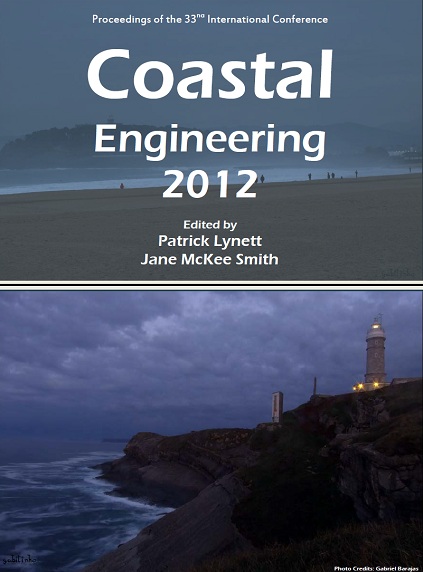Abstract
The Dutch coastal maintenance policy which was implemented in 1990 aims at fighting structural erosion by nourishing sand. Initially, the beaches were nourished. The lifetime of these beach nourishments turned out to be relatively short (~2 yrs), especially at identified erosion 'hotspots' along the North-Holland coast (e.g. Egmond aan Zee). Therefore, from 1999 on, an alternative approach was considered, in which beach nourishments were combined with large nourishments on the shoreface (seaward of the outer breaker bar). In recent years, the evolution of individual shoreface nourishments was analyzed on a spatial scale of kilometres and a temporal scale of years, with a focus on their cross-shore development (e.g., Van Duin et al., 2004). In these studies, their alongshore interaction received little attention. The main objective of the present study is to investigate the evolution and lifetime of five large (~1-2 million m3) shoreface nourishments applied between 1999 and 2005 on a spatial scale that includes the larger part of the North-Holland coast (~40km). The analysis of bathymetrical data shows that all five shoreface nourishments evolved into new outer bars with deep troughs on their landward side, that temporarily interrupted the 'autonomous' cyclic offshore migration of breaker bars (e.g. Wijnberg, 1995). Alongshore, the nourishment placed at Camperduin in 2002 connected to the existing outer bar, while the nourishments placed at Egmond aan Zee and Bergen in 1999 and 2000 respectively, remained isolated. The 2004 Egmond and 2005 Bergen nourishments interconnected into a long bar. At Camperduin, the newly formed outer bar remained quite stable in the years after its placement. The bars resulting from the 1999 Egmond aan Zee and 2000 Bergen nourishments, however, almost fully disintegrated within five years, while the interconnected bar of the 2004 and 2005 nourishments is still largely intact after 5 years. The results suggest that the effectiveness of shoreface nourishments is influenced by their shore-parallel length and their ability to connect to surrounding (natural or nourishment) bars. The observed morphodynamic patterns suggest that the 'lost' sand is mainly redistributed to the breaker zone, and further transported alongshore.References
Grunnet, N.M. and Ruessink, B.G., 2005. Morphodynamic response of nearshore bars to a shoreface nourishment. Coastal Engineering, 52, 119-137.http://dx.doi.org/10.1016/j.coastaleng.2004.09.006
Hillen, R. and Roelse, P., 1995. Dynamic preservation of the coastline in the Netherlands. Journal of Coastal Conservation, 1, 17-28.http://dx.doi.org/10.1007/BF02835558
Ojeda, E., Ruessink, B.G. and Guillen, J., 2008. Morphodynamic response of a two-barred beach to a shoreface nourishment. Coastal Engineering, 55, 1185-1196.http://dx.doi.org/10.1016/j.coastaleng.2008.05.006
Quartel, S., Ruessink, B.G. and Kroon, A., 2007. Daily to seasonal cross-shore behaviour of quasi-persistent intertidal beach morphology. Earth Surface Processes and Landforms, 32, 1293-1307.http://dx.doi.org/10.1002/esp.1477
Ruessink, B.G. and Kroon, A., 1994. The behaviour of a multiple bar system in the nearshore zone of Terschelling, the Netherlands: 1965-1993. Marine Geology, 121, 187-197.http://dx.doi.org/10.1016/0025-3227(94)90030-2
Ruessink, B.G., Van der Grinten, R.M., Vonhögen-Peeters, L., Ramaekers, G. and Lodder, Q.J., 2012. Nearshore evolution at Noordwijk (NL) in response to nourishments, as inferred from Argus video imagery. In: W.M. Kranenburg, E.M. Horstman & K.M. Wijnberg (eds.), Crossing Borders in Coastal Research, Jubilee Conference Proceedings, 20th NCK-days, Enschede, 13-16 March 2012, p. 179-183. DOI: 10.3990/2.194.http://dx.doi.org/10.3990/2.194
Shand, R.D., Bailey, D.G. and Shepherd, M.J., 1999. An inter-site comparison of net offshore bar migration characteristics and environmental conditions. Journal of Coastal Research, 15, 750-765.
Spanhoff, R., and Van de Graaff, J., 2007. Towards a better understanding and design of shoreface nourishments. Coastal Engineering 2006, Proceedings of the 30th International Conference, pp. 4141-4153.
Van Duin, M.J.P., Wiersma, N.R., Walstra, D.J.R., Van Rijn, L.C., and Stive, M.J.F., 2004. Nourishing the shoreface: observations and hindcasting of the Egmond case, The Netherlands. Coastal Engineering, 51, 813-837.http://dx.doi.org/10.1016/j.coastaleng.2004.07.011
Van Koningsveld, M. and Mulder, J.P.M., 2004. Sustainable coastal policy developments in The Netherlands. A systematic approach revealed. Journal of Coastal Research, 20, 375-385.http://dx.doi.org/10.2112/1551-5036(2004)020[0375:SCPDIT]2.0.CO;2
Walstra, D.J.R., Reniers, A.J.H.M., Ranasinghe, R., Roelvink, J.A. and Ruessink, B.G., 2012. On bar growth and decay during interannual net offshore migration. Coastal Engineering, 60, 190-200.http://dx.doi.org/10.1016/j.coastaleng.2011.10.002
Wijnberg, K.M., 1995. Morphologic behaviour of a barred coast over a period of decades. PhD thesis, Utrecht University, 245 pp.
Wijnberg, K.M., 2002. Environmental controls on decadal morphologic behaviour of the Holland coast. Marine Geology, 189, 227-247.http://dx.doi.org/10.1016/S0025-3227(02)00480-2

